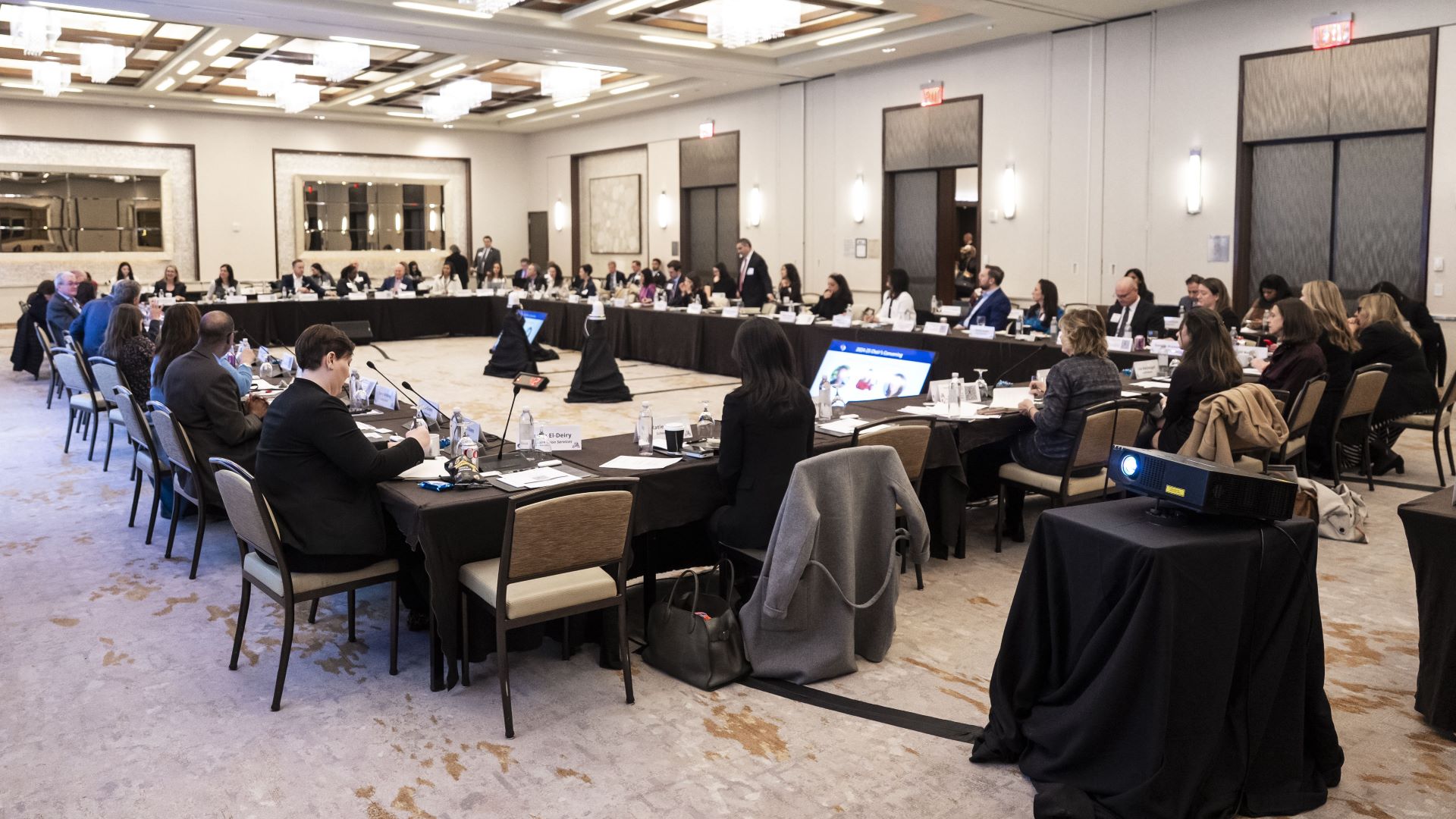Governors have put forth defined plans and made their vision for improving the health of their state or territory clear through their state budgets and State of the State addresses.
by Michelle LeBlanc
Governors began the first quarter of 2022 proposing and enacting state budgets and delivering State of the State addresses. The issues they focused on during their speeches and in the proposed investments outlined in their budgets give a comprehensive picture of Governors’ key priorities. Over the last two years, public health has taken precedence as the COVID-19 pandemic has hit states in waves and altered life for all. Through their speeches and budget proposals, Governors continue to build capacity to improve public health infrastructure, implement best practices to address issues exacerbated by the pandemic and remove barriers to reduce fragmentation across agencies and within health systems.
The National Governors Association Center for Best Practices (NGA Center) Public Health Team compiled priority topics defined by Governors during their State of the State addresses and in their proposed state budgets. Three Governors did not deliver a State of the State address (MT, NC and TX) because the legislature was not in session. Additionally, several states enacted two-year budgets in 2021, covering fiscal years 2022 and 2023 (HI, IN, ME, MN, MT, NE, NV, NH, NC, ND, OH, OR, TX, WA and WI).
State of the State addresses from the nation’s Governors emphasize the varied aspects of public health and the states’ power to address ongoing challenges. This brief explores legislative requests for the 2022 session as well as other specific plans outlined by Governors. While a number of issues emerged, including health care costs and environmental health, the key priority areas were the following:

HEALTH CARE WORKFORCE

The pandemic further highlighted the need to strengthen investments in the health care workforce. Thirty-nine Governors mentioned health care workforce in their budget proposals or their State of the State addresses. Common themes included:
- Training and education;
- Behavioral health workforce;
- State employee salaries;
- Hospital, existing workforce and rural workforce capacity;
- Nursing homes and
- Direct care shortages.
Many states included plans to improve recruitment for nurses, physicians and other clinical jobs through initiatives such as loan forgiveness, scholarships and programs allowing students or trainees to work while learning.
Governor Pritzker, Illinois State of the State and Budget Address
- “That’s why this proposed budget creates the Pipeline for the Advancement of the Healthcare Workforce – or PATH – program. The goal is to model this program after the highly successful Workforce Equity Initiative championed by State Representative Jehan Gordon-Booth. The PATH program will invest $25 million in our community colleges to remove barriers for recruitment and training of new front-line healthcare workers. My budget also proposes to invest new resources in nursing scholarships and loan forgiveness programs.”
Governor Kemp, Georgia State of the State Address
- “That’s why my budget proposals include an initial $1 million for the University System of Georgia to expand nursing programs up to 500 students annually over five years and funding for our Technical College System to grow their partnership with Allied Health to serve up to 700 additional students annually. My proposal will also invest $2.5 million for 136 residency slots and allocate $1 million to Mercer University to address rural physician shortages.”
Governor Reynolds, Iowa Condition of the State Address
- “We’re also starting our training programs earlier, to give our students a first-hand view of what a career in healthcare looks like. In Pella, the high-school Career Academy recently launched a patient-care registered apprenticeship program that offers students hands-on experience in a variety of medical settings, while at the same time earning a wage. Before they even leave high school, these students can become a certified nursing assistant, and then qualify to work as a lab or surgical technician. And within a few short years, they can go on to become an OB tech, RN or BSN – all while being paid. [ … ] That’s why we’re launching a new healthcare registered apprenticeship program that will provide funding to at least five communities to scale what Pella has done.”
Governor Hochul, New York State of the State Address
- “That’s why I’m setting an ambitious goal to grow our healthcare workforce by 20% over the next five years. And we will make the largest investment in healthcare in State history, $10 billion dollars. As we bolster our bone-tired healthcare workforce, we know they aren’t the only heroes of the pandemic.”
Governor Lee, Tennessee State of the State Address
- “Because of our prudent fiscal management, we’re making huge investments in rural healthcare in this budget. And that means actual care, not just keeping hospitals open. We need qualified, dedicated physicians and staff in rural areas. We are dedicating more than $18 million to attract 150 new primary care residents for rural Tennessee.”
Governor Justice, West Virginia State of the State Address
- “[T]his afternoon we announced that Owens & Minor, a Fortune 500 company that provides medical supplies, is going to expand on a deal they previously had with WVU Medicine and create over 125 jobs at a healthcare products preparedness and supply center in Morgantown. Together with the state, Owens & Minor will invest an estimated $50 million in West Virginia.”
MATERNAL AND CHILD HEALTH

Thirty-seven states mention efforts to address varied areas of health policy affecting women, families, parents and children. Common themes include childcare, childhood immunizations, childhood obesity, mental health, expanding postpartum Medicaid coverage, early learning and development programs, infant and maternal mortality and investments in schools and early learning.
Governor Hutchinson, Arkansas Budget Proposal
- The Governor’s FY 2023 budget includes a $66.3 million increase for human services programs, specifically:
- $11.1 million to strengthen the child welfare workforce,
- $37.6 million to reduce the waitlist for services for those with developmental disabilities and
- $6.1 million to increase behavioral health services.
Governor Ducey, Arizona State of the State Address
- “And it’s students of color and those in poverty who have been most impacted by the COVID-era posturing and politics of some school board bureaucrats. So come June, we’re launching a summer camp with an emphasis on catching kids up in key areas: math, reading and American civics. We will lead the way to eliminate learning loss.”
Governor Holcomb, Indiana State of the State Address
- “We will also promote young Hoosier health and wellness by strengthening the guidelines for childhood lead screening and gathering more knowledge about the causes of sudden infant deaths so we can continue reducing infant mortality and saving these precious lives.”
Governor Edwards, Louisiana Regular Session Remarks
- “The budget I have proposed includes:
- $31.7 million for faculty pay raises in higher education;
- $10.5 million for the MJ Foster Promise Program Fund, created by President Cortez just last year;
- $97.2 million for higher education, which includes $5 million for Title IX offices across the state, $15 million increase in GO Grants and $25 million into the Higher Education Initiatives fund;
- $43.4 million for early childhood education, including more than $17 million for the LA-4 Early Childhood program and
- $148.4 million for teacher and support staff pay raises, which is at least a $1,500 raise for teachers and $750 for support staff. This also would be the fifth teacher pay raise since I’ve been Governor.”
Governor Parson, Missouri State of the State Address
- “This year, we are also proposing to double the capacity of our Missouri Autism centers. This will help more families navigate the challenges of treating autism [ … ] [a]nd reduce the backlog for Missouri families desperately needing services.”
Governor Murphy, New Jersey Budget in Brief
- “The Administration proposes increasing State Medicaid spending by $15 million to enhance clinician rates for maternity care for the first time in decades, which will also increase reimbursements for midwives and doulas. The budget proposal also includes $1 million in grants to facilities to increase opportunities for midwifery education and training.”
MENTAL HEALTH

Governors in 33 states mention mental health as a primary objective for 2022 and beyond. Common themes include mental health workforce, cross-agency or department collaboration, children and youth, affordability and access, 988 Suicide and Crisis Lifeline and suicide rates. Many Governors’ budgets propose significant investment to expand mental health services, increase access and support mental health initiatives in schools.
Governor Ivey, Alabama Executive Budget
- The Governor’s FY 2023 budget includes:
- Expanded funding for school-based mental health,
- Expanded funding for children in DHR custody with severe behavioral or mental health issues and
- Funds for two additional mental health crisis centers.
Governor Little, Idaho State of the State and Budget Address
- “Today, I am proposing we accelerate the implementation of the Behavioral Health Council’s recommendations by investing $50 million to improve behavioral healthcare across Idaho. It is one step of many we will take to help prevent tragedy, improve lives and make our communities safer.”
Governor Kelly, Kansas State of the State Address
- “’That’s why I’ve included additional funding in my budget, to make it easier for local communities to provide critical mental health services closer to home, and reduce the strain on our law enforcement agencies, our jails and our hospital emergency rooms.”
Governor DeWine, Ohio State of the State Address
- “While we can never fully remedy the mistakes of the past, we can resolve to change the course of history moving forward by making help visible, accessible and effective in all communities in Ohio. We can do this by investing significantly more resources in the following: We must grow our behavioral health workforce, By increasing research and innovation and By building a community capacity for care that offers better crisis response services and treatment, increased prevention efforts and more residential and outpatient services.”
Governor Scott, Vermont State of the State Address
- “Our mental health system is facing serious stress, and it is not uncommon for emergency departments to have many people in mental health crisis as they await treatment. Which is why we will continue to increase the number of mental health beds throughout the state. And I’ll ask you to expand our mobile crisis pilot and suicide prevention model to make sure when our friends and family, neighbors and co-workers need us most, we have the tools to help.”
Governor Bryan, U.S. Virgin Islands State of the Territory Address
- “We refer to that legislation as the Behavioral Health and Developmental Disabilities Act. The bill clarifies the roles of the departments of Health, Human Services, VIPD, the Bureau of Corrections and other agencies that work with persons with behavioral health issues. It facilitates the expansion of behavioral health services in the Territory and addresses the collaboration of public and private partners. This important bill helps us to get a grip on not only behavioral health issues but on the chronic homelessness and danger to the community that often results.”
SUBSTANCE USE DISORDER

Mental health and substance use disorders (SUD) are linked in many ways with several overlapping populations, treatments and funding streams. Throughout the pandemic, there has been increased alcohol and drug use and a spike in overdose deaths, mainly from opioid use. Governors in 29 states mention mental health disorders and SUDs and present a variety of plans to help treat these disorders. Common themes include preventing overdoes, bolstering the behavioral health workforce, supporting recovery housing and providing funding to support increased services for prevention and treatment.
Governor Carney, Delaware State of the State
- “We also continue to tackle the epidemic of substance abuse statewide. Our Lieutenant Governor’s leadership of the Behavioral Health Consortium is having a real impact. Despite the national rise in overdose rates during COVID, Delaware was one of only four states to see a decrease in the rate of overdose deaths. The Lieutenant Governor will continue to be a driving force to ensure access to treatment and prevention.”
Governor DeSantis, Florida Freedom First Budget
- “The budget includes more than $82 million in total funding [to combat the opioid crisis]. This funding will provide evidence-based prevention services and supports, medication assisted treatment and recovery services and will enhance drug overdose surveillance. [ … ] Additionally, this funding will provide a comprehensive array of behavioral health treatment services that seek to reduce overdoses, suicides, unemployment and help break the cycle of hospitalization and homelessness.”
Governor Burgum, North Dakota State of the State Address
- “We’ve increased funding to improve access for addiction programs. We’ve expanded behavioral health crisis services to all regions of the state. And we’ve launched new recovery programs that include supportive housing. But there’s more to be done. And we’ll continue to meet these challenges through collaboration, through innovation and action.”
Governor Wolf, Pennsylvania Budget Address
- “Our budget surplus is not an excuse for a spending spree – but it is a chance to make more investments that can open the doors to opportunity for more Pennsylvania families. [ … ] More investments in health care [can be made] so we can fight the opioid epidemic and improve mental health.”
SOCIAL DETERMINANTS OF HEALTH

Social determinants of health (SDOH) include a variety of social and environmental factors that impact an individual’s quality-of-life outcomes and risks. Some of these things include transportation access, social discrimination, education, income, job opportunities and access to food and clean water. While housing falls under this umbrella term, it will be addressed more specifically later in this publication. Seventeen states mention equity and social determinants of health (outside of housing) more explicitly in their addresses. Some common themes include food insecurity, child-care, broadband access, collaborative equity efforts and enhancing diversity in workforce programs.
Governor Dunleavy, Alaska State of the State Address
- “As we announced last month, the People First initiative is the umbrella for five distinct initiatives addressing our most critical problems that impact our most vulnerable:
- domestic violence and sexual assault
- human trafficking
- missing and murdered Indigenous persons
- the foster care system
- homelessness
- These are not top-down proposals. They’ve been crafted from the ground up based upon the input of multiple stakeholders in a process that started in November 2020. The People First Initiative is a mix of statutory changes, additional personnel, administrative orders, technology and increased resources to tackle these longstanding, serious problems.”
Governor Ige, Hawaiʻi State of the State Address
- “That’s why our Department of Human Services developed online applications for SNAP benefits (formerly Food Stamps) and added 32,000 additional families during the pandemic. [ … ] To help them, the state’s Child Care Program Office is distributing nearly $80 million to support access to childcare and provide much needed relief for young families.”
Governor Reeves, Mississippi State of the State Address
- “If we want to break the cycle of recidivism, we must invest in a cycle of education and learning. That’s why in my most recent Executive Budget Recommendation, I proposed allocating $2 million for re-entry programs geared toward Mississippians who will be eligible for parole within six months. Additionally, I’ve proposed funding to expand the work release pilot program – that has already shown so much promise – to each of Mississippi’s 82 counties.”
Governor Youngkin, Virginia Address to the Joint Assembly
- “[We can] make crucial investments in those critical pillars to the great Virginia promise of a lower cost-of-living, excellent schools, safe communities, a rip-roaring economy that lifts up all Virginians and a state government that works for Virginians.”
Governor Evers, Wisconsin State of the State Address
- “I’ve also directed more than $100 million through federal pandemic aid to expand access to reliable, affordable, high-speed internet across our state. These funds alone – which included the largest single round of broadband funding in state history – are projected to give new or improved broadband access to more than 110,000 Wisconsinites in nearly 50,000 homes as well as almost 2,200 businesses.”
Governor Gordon, Wyoming State of the State Address
- “[Food insecurity programs] like Food from the Field, Food from the Farm and Ranch and one of my favorites [ … ], Grow a Little Extra, have made the lives of so many of our citizens better.”
OLDER ADULTS AND AGING

The number of Americans over the age of 65 is projected to increase from 54.1 million in 2019 to 94.7 million in 2060. Seventeen states mention plans for older adults and aging populations. Common themes were nursing home funding, direct care shortages, Alzheimer’s-related policies, veterans, collaborative efforts across departments and social isolation of older adults.
Governor Polis, Colorado State of the State Address
- “Looking ahead, I am proposing that we waive licensing fees for nurses and mental health care workers as well as for our nursing homes and assisted living facilities whose residents have been particularly vulnerable throughout the pandemic.”
Governor Beshear, Kentucky Budget in Brief
- “Federal pandemic funds have eliminated a waitlist of about 7,000 meals. These funds expire December 31, 2021. The Governor’s budget includes $36.2 million over the next two and a half years to continue providing an additional 49,000 meals per week fully meeting the current need for meals to Kentucky’s senior citizens age 60 and older living in the community. The waitlist prior to the use of federal pandemic funding was approximately 7,000 Kentuckians.”
Governor Mills, Maine State of the State Address
- “Tonight, I am announcing that I will convene a Silver Cabinet – a mirror to our Children’s Cabinet – to mobilize our people, to eliminate silos across State government and to enhance coordination and communication among all players to address long-term care issues and ensure that every person in Maine may age safely, affordably, in a way that best serves their needs.”
Governor Stitt, Oklahoma FY 2021 Executive Budget
- The Governor’s FY 2023 budget includes measures to:
- Continue outreach to increase awareness of State Veterans Homes and veterans benefits and programs offered through the Claims and Benefits and Veterans Services programs,
- Commence operation of the new State Veterans Home in Sallisaw,
- Begin construction of a replacement State Veterans Home in Ardmore and
- Renovate the current Sulphur Veterans Center to a Geriatric-psychiatry long-term care facility for veterans in Sulphur.
HOUSING AND HOMELESSNESS

From a 2021 survey, almost half of Americans believe affordable housing in their local community is unavailable or inaccessible. Additionally, there was a 20 percent increase in the number of sheltered individuals with chronic patterns of homelessness between 2020 and 2021. Governors in sixteen states mention housing and homelessness in their addresses. Common themes among Governors’ plans included investing in affordable housing and lowering housing and rental costs.
Governor Baker, Massachusetts Governor’s Budget Message
- “Building on that commitment, this budget includes significant investments and policy reforms for rental assistance, re-housing benefits and housing vouchers with the goal of reducing evictions and shelter entry. An increase of $132.4 million across several housing programs paired with proposed changes to expand eligibility and increase benefits will allow for long-lasting improvements in housing stability and access to homeownership and expedite recovery for families whose need has been exacerbated by the COVID-19 pandemic.”
Governor Sununu, New Hampshire State of the State
- “I’m proposing the InvestNH Housing Incentive Fund – a historic $100 Million Fund using ARP dollars to rebuild and expand Housing for New Hampshire’s next generation.”
Governor Brown, Oregon State of the State Address
- “I will level with you: Housing affordability and homelessness are not issues we can solve overnight. This crisis has been decades in the making, and in the last two years it has only worsened due to the pandemic and natural disasters. [ … ] This session, I am asking the Legislature to join me in supporting an additional $400 million investment in affordable housing.”
Governor McKee, Rhode Island State of the State Address
- “Did you know that homeownership is one of the most important ways to build generational wealth, yet Rhode Island has one of the lowest homeownership rates in the country, largely because families and individuals cannot afford the down payment? [ … ] That’s why I will be sending the General Assembly a proposal for investing $50 million to provide down payment assistance to Rhode Island households who need it most.”
Governor Cox, Utah Fiscal Year 2023 Budget Recommendations
- The Governor’s FY 2023 budget:
- Recommends $50 million to foster the development of more than 1,100 affordable housing units across the state through private activity bonds,
- Recommends $50 million for the new construction or rehabilitation of rural workforce housing so all areas of our state can benefit from an accessible, competitive labor pool and
- Notes alleviating homelessness remains critical and recommends $128 million in ARPA funds for more than ten housing projects across the state that serve individuals making less than 40 percent of the area median income.
PUBLIC HEALTH INFRASTRUCTURE

State public health programs include infectious disease monitoring, injury prevention, immunization and a range of other vital services that are the core for planning, delivering and evaluating the health of communities. COVID-19 has illustrated the need for strong, yet nimble infrastructure to address emerging issues and cover the diverse issues and populations addressed through public health programs. Fifteen Governors mention public health infrastructure in their addresses, addressing topics like investing in emergency response, bolstering data collection and modernizing systems.
Governor Newsom, California Governor Budget Summary
- “The Budget includes $100 million General Fund annually for DPH to strengthen statewide public health infrastructure and complement local funding so that state and local governments can collaboratively work together to improve the health of all California.”
Governor Ricketts, Nebraska State of the State Address
- “I cannot stress it enough: ARPA funds are one-time funds. They must be spent as such. Each one of us has a responsibility to guard against spending this money in a way that grows government expenses. My proposal includes 29 qualifying initiatives that will better Nebraska. It will deliver nearly $200 million for public health emergency response.”
Governor Lujan Grisham, New Mexico Executive Budget Recommendation
- The Governor’s budget:
- Proposes $200,000 to fund an IT system to integrate data and produce data analytics for a variety of programs including the licensure and incident management system for both the developmental disabilities support division and the healthcare, certification and licensing division and
- Proposes funds for New Mexico’s healthcare infrastructure in underserved areas for the rural and primary healthcare clinics and improves access to quality healthcare services to reduce health risks to persons at risk of adverse health outcomes.
Governor Noem, South Dakota Special Appropriation Recommendations
- “The Governor is recommending an increase of $1,737,500 in federal fund expenditure authority for the Department of Health to equip emergency medical transportation with telehealth capabilities.”
ADDITIONAL NOTABLE POLICIES
Governors in several states also mention lowering health care costs, addressing environmental health and bolstering public health infrastructure as key priorities.
HEALTH CARE COST
Governor Lamont, Connecticut Budget Recommendations
- “Proposing legislation to make prices more transparent, safely re-import lower-cost prescription drugs from Canada and cap run-away prices on prescription drugs here at home.”
Governor Hogan, Maryland Budget Highlights Fiscal Year 2023
- The Governor’s budget expands several existing healthcare programs and launches new healthcare programs.
- More than $40 million is provided across FY 2022 and FY 2023 to establish a young adult subsidy pilot program through the Maryland Health Benefit Exchange to assist eligible young adults with paying for their monthly health insurance costs.
- The budget includes more than $32 million to expand coverage and reimbursement requirements for services provided through telehealth to both Medicaid and private insurers.
- Nearly $13 million ($5.6 million in general funds) supports expansion of the Community Options program to help an additional 400 enrollees receive care at home or in their community.
Governor Whitmer, Michigan State of the State Address
- “Attorney General Dana Nessel took action. She launched an investigation under the Michigan Consumer Protection Act into one of the three largest drug companies that makes nearly all the insulin in the U.S. Meanwhile, in the Michigan Legislature, there have been bipartisan bills introduced to cap the cost of insulin at $50 bucks a month. We all agree that insulin costs too much, and I know we can work together to hold drug companies accountable, lower costs and save lives.”
Governor Sisolak, Nevada State of the State Address
- “[T]he cost of insulin has tripled over the last decade to nearly $300 per vial. Lifesaving cancer drugs can cost hundreds of thousands of dollars per year. That’s why today, I’m announcing that Nevada will join the Northwest Prescription Drug Consortium, along with Oregon and Washington State. By negotiating with drug companies together, we can start holding them accountable and get costs down.”
ENVIRONMENTAL HEALTH
Governor Walz, Minnesota Proposed Supplemental Budget
- “The Governor recommends a grant program for projects targeting the reduction of lead in drinking water in public and private schools and childcare facilities. These grants will fund the remediation of plumbing and fixtures that are known to contain lead. Reductions in exposure to lead in water will improve the health and safety of Minnesota’s children through enhanced brain development and increased lifetime productivity.”
Governor McMaster, South Carolina State of the State Address
- “In rural South Carolina, water and sewer is key to life, to good public health and economic health. And it’s key to a community’s health. [ … ] The state’s rural water, sewer and stormwater infrastructure is becoming old and outdated. Many of these systems have exceeded their useful life, some are barely hanging on. [ … ] I have proposed that we use $500 million in federal funds to transform these water, sewer and stormwater systems in our state’s poorest counties. To upgrade or replace deficient rural water and wastewater systems. And to incentivize large systems to connect with smaller and faltering systems.”
Governor Inslee, Washington State of the State Address
- “With buildings lasting anywhere from 50 to 100 years, we must act now to give Washingtonians more efficiencies and to decarbonize our homes, apartments, offices, retail spaces and more. To accomplish this, we have to require gas utilities to chart a path to decarbonize under the Climate Commitment Act. We can improve conditions for developers to grow clean energy resources here in our state.”
CONCLUSION
Governors laid out their priorities for the next year through their state budgets and State of the State addresses. Although each Governor has their own plans, common themes emerged. They proposed clear strategies to address issues worsened during the public health emergency such as mental health, substance use disorder, health care workforce, housing and public health infrastructure. Governors also proposed plans to improve the health and safety of specific populations, including families, parents, women, children, older adults, people experiencing homelessness and groups that have increased susceptibility to adverse health outcomes due to inequitable access to needed resources. Several Governors plan to address distinct health policy issues, from clean water and environmental health to insulin prices and health care costs. Overall, Governors have put forth defined plans and made their vision for improving the health of their state or territory clear through their state budgets and State of the State addresses.











